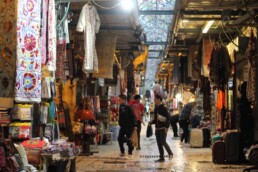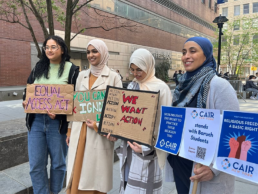Amid Israeli Red Tape, Married Palestinian Couples Struggle to Remain in Jerusalem
BETHLEHEM, WEST BANK - In 2015, on the first evening of the Christian camp, Maria* and Michal met for the first time. After dinner, they peeled away from the crowd to admire the statue of the Virgin Mary that stood at the front of the church. Maria, who was 18 at the time, sat in an empty church in the West Bank, deep in conversation with a man who would soon become her husband.
Maria and Michal grew up within a 15km radius of each other — her in Jerusalem and him in the West Bank. As they sat under the watchful eye of the mother of Christ, they talked about everything — their families, their devotion to their faith, their love for their land.
“It was so natural and easy to speak with him — we connected on so many levels,” said Maria.
The two fell in love that night and got married in July 2022. For Maria, getting to marry Michal was a victory — she had to face many hurdles to get there.
“My dad was initially quite resistant to the idea of us getting married,” said Maria.
Maria's father, Joseph*, 58, is a tour guide who was born in the old city of Jerusalem. His hesitancy with his daughter’s marriage steamed from hardships he faced from his own experience marrying Maria’s mother, Grace*, 53, because she is also from the West Bank.
“I did not want my daughter to go through all the hardships my wife and I faced,” said Joseph.
Both Joseph and his daughter were born in Jerusalem, which means that they have a Jerusalem identification card. This card allows them to move freely through checkpoints between checkpoints between Jerusalem and the West Bank. Grace and Michal, on the other hand, were born in towns in the occupied West Bank which means they are not entitled to a Jerusalem identification card.
To obtain one, Grace had to apply for a special residence permit through the Ministry of the Interior in Israel. However, applying for this permit is challenging. Joseph and Grace had to wait for 20 years before they finally obtained this permit. During that time, Grace had to constantly reapply for a work permit to stay in Jerusalem every few years. They managed to stay together in Jerusalem but were never fully confident that they would not be separated.
Joseph and Grace faced several ups and downs over the 20 years, but the one thing that helped Grace overcome challenges was her faith. Every week, she would go to the Church of the Holy Sepulchre to pray. As she kneeled by the marble slab near the entrance where Jesus was laid, she prayed for her family and for her fellow Palestinians in the same situations. For Grace, praying at the Church of the Holy Sepulchre was a blessing, and she believed that whatever she asked for will be fulfilled.
“Jerusalem is a very holy place. I have faith that it is worth staying here. I know I will be able to fulfill my life as a Christian here,” said Grace.
When Joseph and Grace got married in 1996, they moved into Joseph’s parent’s house in the Muslim quarter of Jerusalem. At that time, Joseph worked in accounting and was adamant about staying in Jerusalem to maintain his own ID. While Palestinians born in Jerusalem are born with the right to an identification card, they also go to great lengths to maintain their Jerusalemite status. Those with the ID must be able to prove that Jerusalem is their “center of life”. This means that they need to remain in Jerusalem and be able to prove that they spend the majority of their time there.
For Joseph, this meant living in the same house his parents owned since he was young, collecting electricity and water bills to prove that he was using the residency monthly. He even had to ensure that his fridge was stocked with food to prove that he lived at home as Israeli government officials sometimes came to check. Despite the challenge, it was worth it.
“As a Palestinian, and as a Christian, we must continue our presence here in Jerusalem,” he said.
Palestinian Christians currently make up around 1% of Jerusalem’s population, but the number of Christians have been slowly dwindling. For Joseph, staying in Jerusalem despite the falling numbers is his way of defying expectations and ensuring that those like him are still represented. For this reason, he became a tour guide.
“I want people to know that this place, which is so important to Christians, still has Palestinian Christians, I want them to know our history,” said Joseph.
When Joseph and Grace got married in the late 1990s, the situation with the security checkpoints between Jerusalem and the West Bank was different than they currently are. Even though the checkpoints existed, it was easier for Palestinians to move in and out of Jerusalem as they did not always require a permit to do so. It wasn’t until a period of unrest known as the Second Intifada in the early 2000s when security on the Israeli side got much stricter and all Palestinians were required to have a permit when moving into and out of Jerusalem.
Things became a lot more challenging for the couple after that — Grace had to constantly reapply for a work permit to stay in Jerusalem and was in constant fear that she could lose it at any moment. Palestinians without an ID also undergo much more scrutiny when crossing checkpoints than those with an ID.
Whenever Grace and Joseph would drive through a checkpoint, Grace was required to step out of the vehicle and walk through a separate line with body scanners while her husband and kids were able to pass through the checkpoint in the comfort of their car. Once she passed through the other side of the metal detectors, she usually had to trek a couple of kilometers on foot past the intimidating barbed wires to where Joseph and the kids were waiting for her. At times, the officers manning the checkpoints would take a break, and those in line would be stranded for hours, hoping that someone would return so they could cross to the other side.
“It was so humiliating and dehumanizing,” said Grace. “Having your kids watch you go through is something I wish no one has to go through."
This process still stands today. Whenever Maria and Michal cross the checkpoint into Jerusalem, Michal has to get out of the car while Maria stays in the vehicle.
“We try to avoid going into Jerusalem because of the checkpoint,” said Maria. The pair currently lives in Kafr Aqab, a neighborhood at the edge of Jerusalem designed for couples where one has the Jerusalem ID and the other does not.
Grace also avoided crossing the checkpoint as she was fearful of the process. During the 20 years she lived without an ID card, she visited her family maybe a handful of times. She would long to go back to Ramallah to see them during Easter and Christmas, significant times of year for her as a Christian, but often opted out because of fear and embarrassment.
“One year, I just chose to stay home because I knew I would not be able to get through even though I wanted to go with my kids and see the lights,” she said. “I remembered just crying that entire night knowing I could not experience it.”
In late 2003, Grace's father fell gravely ill. However, Grace’s work permit had expired and as she waited for a new one, she knew that she would not be able to visit Ramallah and then return to Jerusalem to be with her kids. Though it was an incredibly painful decision, she could not leave Jerusalem to visit her family. She did not get to see her father during his last few days and was unable to attend the wedding.
“It is something I still think about, and it makes me really sad,” said Grace.
In addition to difficulties at the checkpoint, the cost of living in Jerusalem was another struggle for Joseph and Grace. As a Jerusalemite, Joseph had access to healthcare from Israeli institutions, but Grace did not. They had to opt for private insurance for her, which was incredibly expensive.
For Joseph, practicing his faith gave him strength to face the hardships. He thinks of the story of resurrection whenever things get challenging.
“Jesus rose for us. It gives me strength because I will continue to rise and keep going,” said Joseph.
In 2013, Joseph and Grace approached a lawyer who was working with several other families who were also trying to obtain a Jerusalem ID card. The process cost them around $8,000 USD. In 2016, Grace finally obtained her identification card.
“I was so happy. The first thing I did was take a picture and send it to my sister,” said Grace.
The second thing she did – drive through the Hizma checkpoint, a checkpoint she said she was never able to get past when did not have her Jerusalem ID card.
After reflecting on her experience, Grace's tone grew somber thinking about what her daughter must undergo.
“I want an easy life for them. I don’t want them to suffer how I had suffered,” said Grace.
Maria and Michal want to apply for the special permit but must wait until Michal turns 35 because the application mandates that men must be at least 35 years old before applying. As of March of this year, the Knesset passed the Citizenship Law, which denies Palestinian naturalization into Israel. Under this new law, Palestinian couples can obtain a residency permit which lasts for up to two years. However, this residency permit can be revoked at any point in time on security grounds.
Though Maria is worried about this new law, and knows that the road ahead for her and her husband will not be easy, she is not ready to give up just yet.
“Religion was the most powerful engine that helped my parents stay in Jerusalem.” said Maria. “I hope it will help us, too.”
* The sources requested that we publish only their Christian first names to avoid being identified because they feared retribution by the Israeli government.
Muslim Students Lead Protest for Adequate Prayer Space at New York’s Baruch College
Thursday's protest, coming on the final day of Ramadan, was one of the larger weekly protests students have organized over the past two months.
As published in Religion News Service.
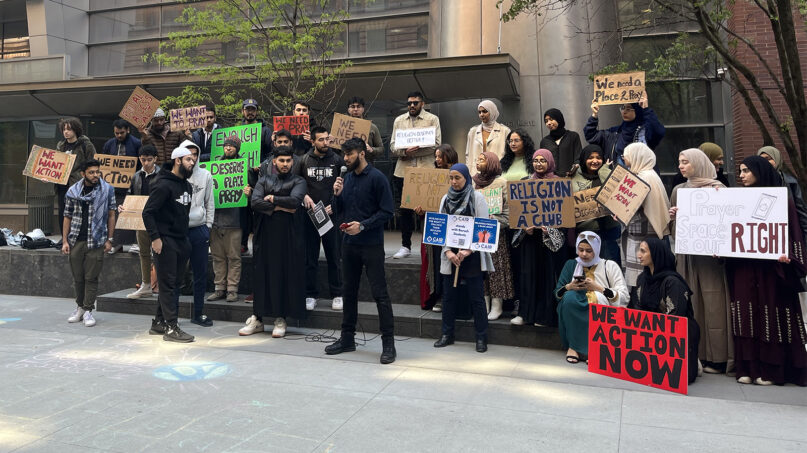
NEW YORK — Loud chants carried through the main plaza at Baruch College in the early afternoon on Thursday (April 20) as a group of around 40 students protested near the Office of Student Life. The students, a majority of them Muslim, were calling on the administration to offer better, more accessible interfaith spaces.
The campus, located a few blocks east of Manhattan’s Madison Square Park, currently offers an interfaith space (room 3-225 in the William and Anita Newman Vertical Campus) that fits around 15 students, and for a college with more than 500 Muslim students, students say the room is not big enough to meet their needs.
“It’s so hard to pray. The room is so small, people end up stepping over each other and it’s a hazard,” said Ayub Tursonzadah, a Muslim student at Baruch College and one of the protest organizers.
Thursday’s protest, coming on the final day of Ramadan, was one of the larger weekly protests students have organized over the past two months. The prayer room was extra crowded during the holy month of fasting and prayer, Muslim students said.
Muslims pray five times a day, and men and women are required to pray separately. With the size limitations of the current interfaith space, the women have had to find other spaces to pray.
“Because of modesty reasons, the women need a private space to pray. We now use the club space allocated to the Women in Islam club. But it’s the size of a closet,” said Zoya Cheema, the president of the Muslim students’ association and one of the student organizers for the protest.
Uswa Anwar, a Muslim student at Baruch, said it has not been easy. She has had to miss parts of classes because she had to wait for her turn to pray. She believes being part of the protest is the only way forward at this point.
“None of us want to be here protesting for this. But we aren’t being heard. We are being brushed aside,” she said.

The effort for better interfaith space began at Baruch last spring when Muslim students first tried to approach administrators at the Office of Student Life to ask for a better prayer space. Students were given a larger interfaith space during the 2021-22 school year while Baruch College was operating remotely. However, toward the end of the spring semester, administrators reassigned the interfaith space back to room 3-225, which, in addition to being small, has ventilation issues, said protesters.
After receiving no responses from the administrative team, a group of Muslim students started praying inside the lobby of student life to silently protest and gather attention during the 2022 fall semester. The students were able to obtain a meeting with Dean Art King, but said they were disappointed with the results.
“We weren’t offered any solutions. We were told this is a Muslim student club issue, but it’s an issue for everyone,” said Tursonzadah.
Though the protests are for interfaith spaces — and have included students of other faiths and no faiths — Muslim students have been at the forefront, largely due to the size of the Muslim population at the college. But being so visible has been nerve-wracking for some.
“We already have such a reputation being Muslim in this country, so we were afraid of how people would perceive us. But we want to stand up for what is right,” said Cheema.
Student organizers have been working with the Council of American Islamic Relations New York, who have worked with students at other City University of New York schools to secure a better interfaith space.
“Baruch College must adhere to the First Amendment right to not discriminate against students of faith. If they provide adequate space for non-religious students, they are obligated to provide the same for religious ones,” said Ahmed Mohamed, the legal director at CAIR New York.
The Baruch protest comes at a time when university administrators across the country have been grappling with how to best accommodate the growing religious diversity on their campuses — from serving halal and kosher food to allowing athletes to wear head coverings. Last year, students at City College, another CUNY school, faced the same issue those at Baruch are currently dealing with and were able to work with administration to secure an interfaith space that works for students.
Elsewhere, the tensions have escalated to lawsuits. California State University has been sued over a new caste discrimination policy with allegations that it singles out Hindu students and staff. Hamline University is being sued over its decision not to renew the contract of an adjunct professor who showed a 14th-century painting of the Prophet Muhammad in her online class last semester.
Kayla Aaron, a Jewish student at Baruch, said she and other Jewish students have faced similar issues as Muslim students when accessing the interfaith space.
“We could not find a place to pray. The room was not big enough. We ended up praying in a public space where people eat their lunches,” said Aaron, describing a time last semester when she and other Jewish students were trying to pray.
Students from non-religious backgrounds have also come out to show their support.
“It’s an important issue and I want to show my support. Having a space for people to congregate creates community, and I am in support of that,” said Matthew Taberas, a student at Baruch.
The administration at Baruch College did not directly respond to yesterday’s protest, but issued a press statement at yesterday’s protest, where they expressed support for the new referendum proposal brought forward by the Undergraduate Student Government executive board last week. The referendum proposes renting an off-campus space for interfaith use that would be funded by a $25 increase in activity fees for full-time students. For the referendum to be considered, the USG board has asked students to sign a proposal for its consideration by end of day Friday.
While some see this as a solution, students at the protest do not.
“Tuition is already an expense for these students, they should not be charging more for students to have a space to pray,” said Rosa Gomez, a Christian student at Baruch College who spoke at the protest yesterday.
Students say they will continue to protest until their needs are met.
“We are going to keep going until we have a space to pray,” said Anwar.
Day 1: In the Footsteps of Christian Pilgrims
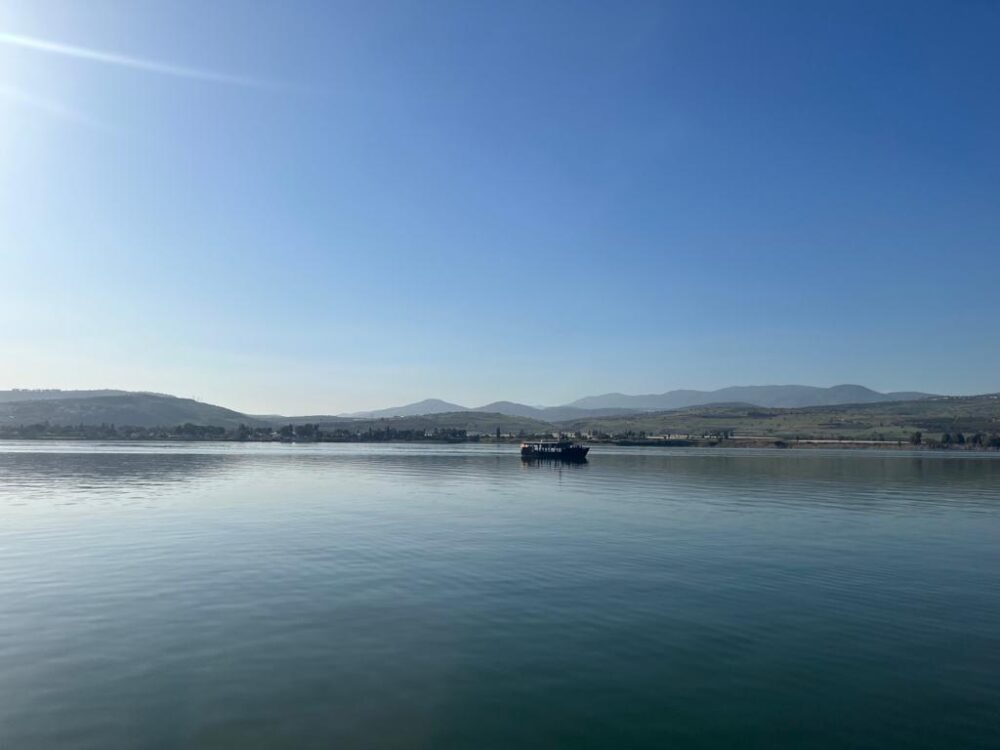
The New Testament describes the miracles Jesus performed — many of them near the Sea of Galilee, in the northwestern corner of Israel, where he spent much of his adult life. The Sea of Galilee, the lowest freshwater lake on Earth, was the focal point of today’s trip for us on our first day in the Holy Land.
At 7:50 a.m. sharp, we hopped on a bright blue bus, still jet-lagged and groggy from our late arrival in Nazareth the night before. After driving about two hours north, we were greeted by the sun sparkling on the lake on which Jesus once walked, Christians believe.
Our first stop was the Church of the Beatitudes, which was packed with pilgrims from all around the world. Built by Antonio Barluzzi in the 1930s uphill from Byzantine ruins where Jesus delivered the Sermon on the Mount. The church overlooks the Sea of Galilee. To the west of the lake are the towns of Galilee and Tiberias, and to the left was the Golan Heights.
It was here where our tour guide, Akiva Sygal, explained the significance of the lake, and why fish play an important role in Christianity.
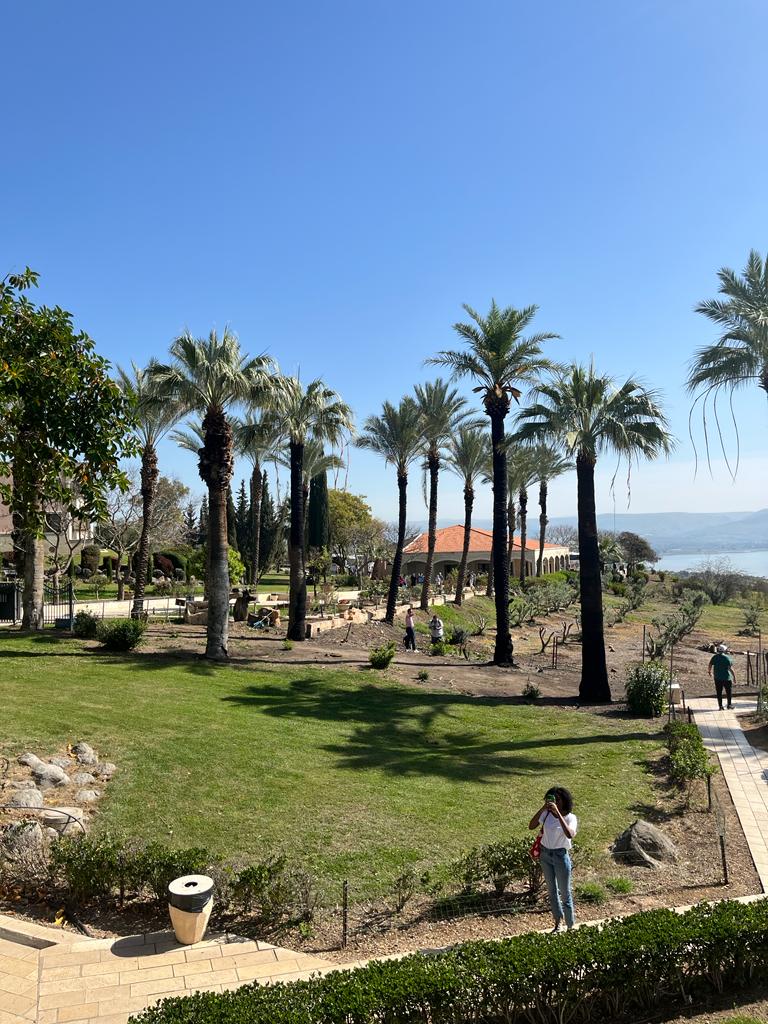
Jesus began preaching after he turned 30. Surprisingly, there aren’t any accounts of what his life really looked like before this time. When he became the leader of a new faith in a place where Judaism was still very much the dominant religion, he started preaching to fishermen in the sea’s coastal towns — those men became his first disciples, and fish became a symbol in Christianity. — The symbol of fish was also a way for Christianity to differentiate itself from Judaism and represent a fresh new idea, which has now become one of the world’s biggest religions.
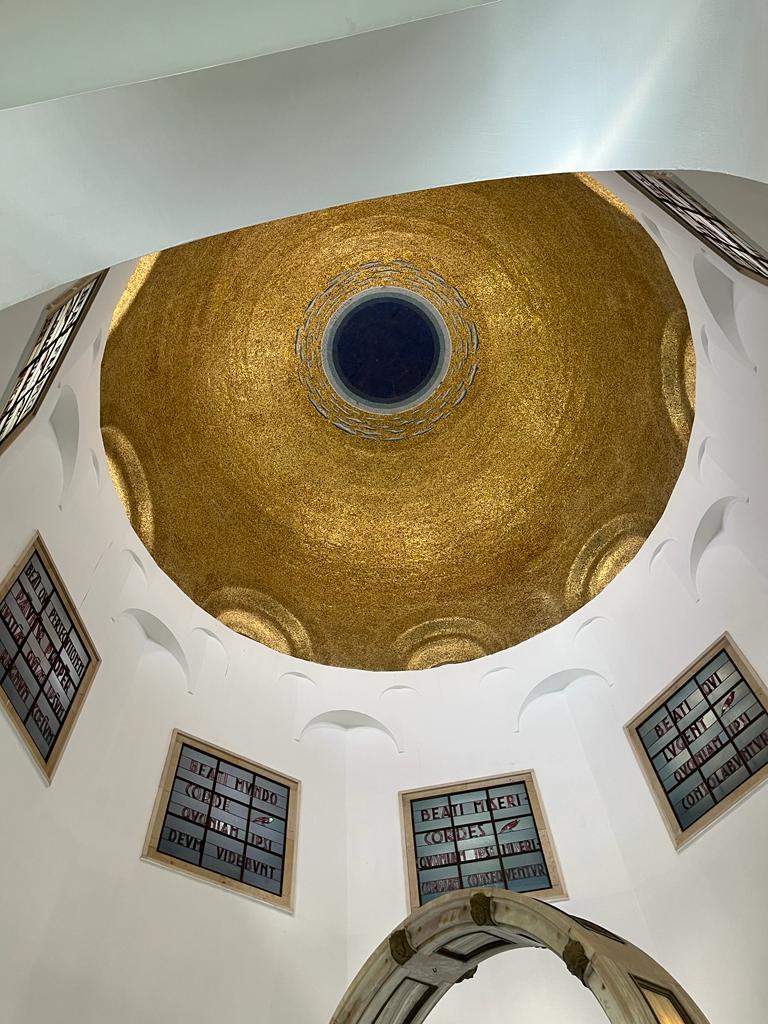
It was at the Church of the Beatitudes where we were introduced to a little book called the New Covenant. The Bible, the holy book for Christians, is composed of the Old Testament (which those who practice the Jewish faith refer to as the Torah) and the New Testament, which describes Jesus’s life . In Israel, most buildings, homes, and hotels already have the Old Testament. For those who are Christian, they can get a small book called the New Covenant which just contains the New Testament.
Our next stop was the Capernaum, a fishing village located on the northern shore. This is where it was believed that Jesus had given his first sermon in the synagogue.


For me, the most interesting thing about Capernaum was the history of how it slowly transformed from a Jewish town to a mixed Jewish-Christian community. In its early years, Christians practiced their faith secretly. Disciples designated a house in the Jewish village as a Church, and they slowly started coming to pray covertly. As Christianity grew more dominant, a formal church was built in its place. Ruins of a massive synagogue stand nearby.
It is here where we learned the verb “to capernaum,”–to be messy (a term Fiona actually already knew).
The next stop was the Church of Multiplication, a Roman Catholic church located at Tabgha, on the northwestern shore of the Sea of Galilee. We were introduced to the Christian story of the 5 loaves and 2 fish, with which Jesus was able to feed 5,000 people. The courtyard was peaceful, with a small area for 2 fish and an olive tree.
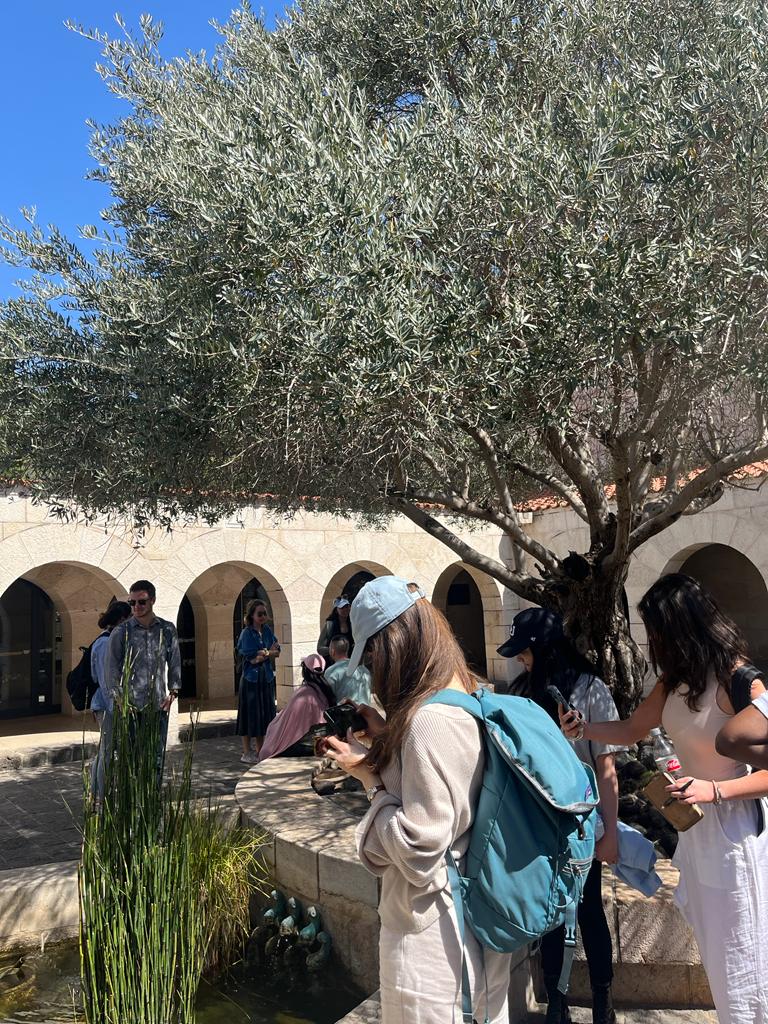
We traveled next to the coastline town of Tiberias, a Jewish town. It’s an important area for the Jewish community today, but this was not always the case. When the Roman Empire swept past Jerusalem, they burned down the Jewish temple, and the community found refuge in Tiberias. It became a holy site for the Jewish community, where it could visit the graves of rabbis, scholars and poets who lived in the city. While the Jewish faith considers graves to be a space of impurity, they also represent history, and in time may become holy sites.
Before 1948, Tiberias was a mixed Arab and Jewish town, and in 1948, it became the first Jewish town of Israel. We visited the tomb of the Rambam, or Maimonides, and what remains of an abandoned mosque where Muslims once docked their boats and completed daily prayers.

Our next stop was onto a large wooden boat, which took us around the Sea of Galilee
This was the first time during the day that we were able to sit back, relax and enjoy Arabic songs and one of the most iconic pieces of music, “Here Comes the Sun” by the Beatles.
Refreshed and on the verge of an afternoon siesta, we headed to our final stop of the day - Kibbutz Ein Gev. It is here that we met a longtime Israeli resident of the kibbutz. He told us the history of kibbutzim, Israeli community settlements–often agricultural–where members live, work, and eat together.

The two most important values of a kibbutz are cooperative and communal living. In fact, we learned that the kibbutz was a safe space for refugees who fled the Soviet Union in the early 1990s. Our conversation Was briefly interrupted as a group of children drove nearby on their toy tractor, waving at us before we headed back to Nazareth. The speaker told us that kibbutzim were uniquely Israeli, and that while other communities throughout history have tried to live communally, each culture had to find a version of that works for them.
“You can take the idea of a kibbutz, but you can’t copy it” exactly, he said.
Stay tuned for tomorrow’s adventures told through the eyes of the lovely Ania and Nora!

